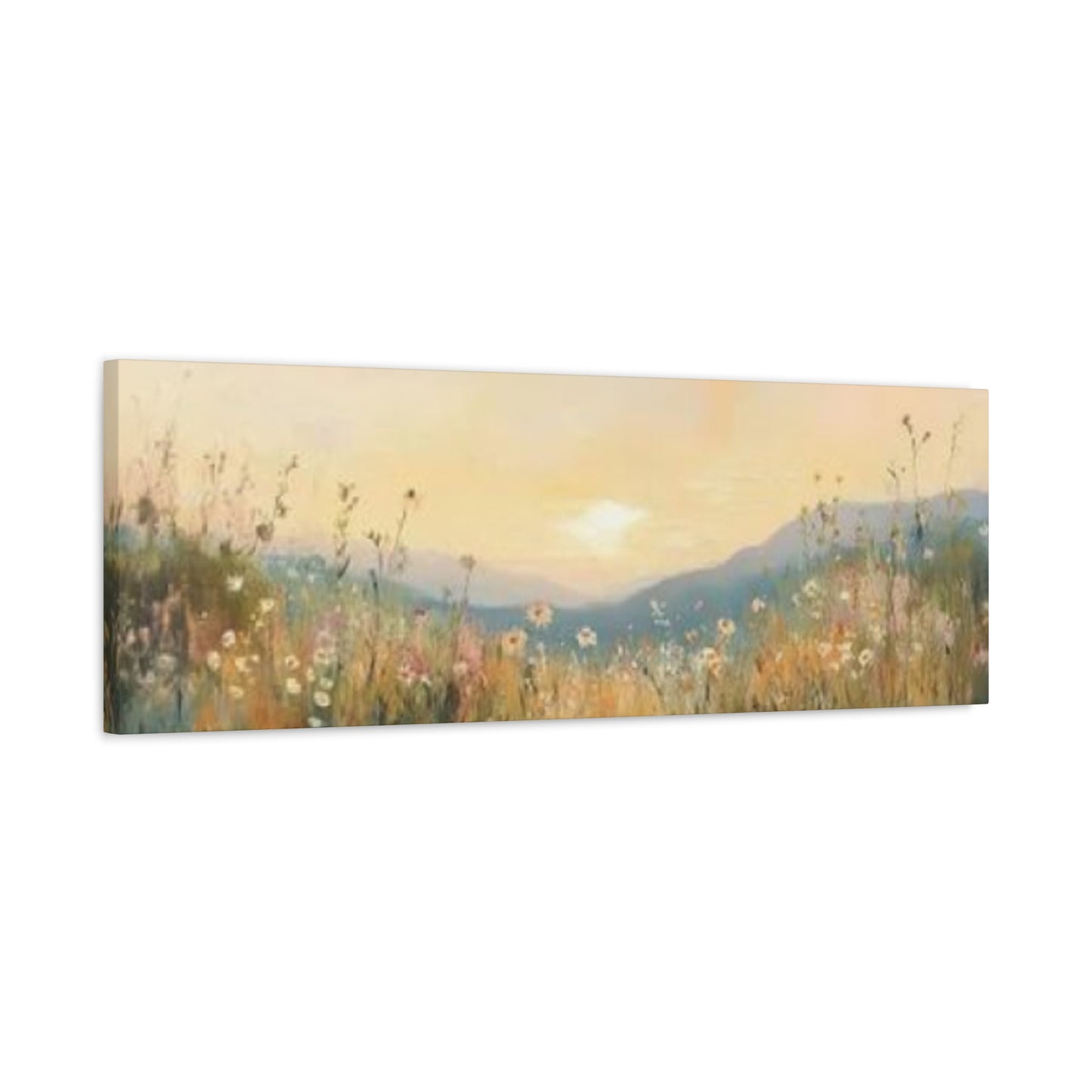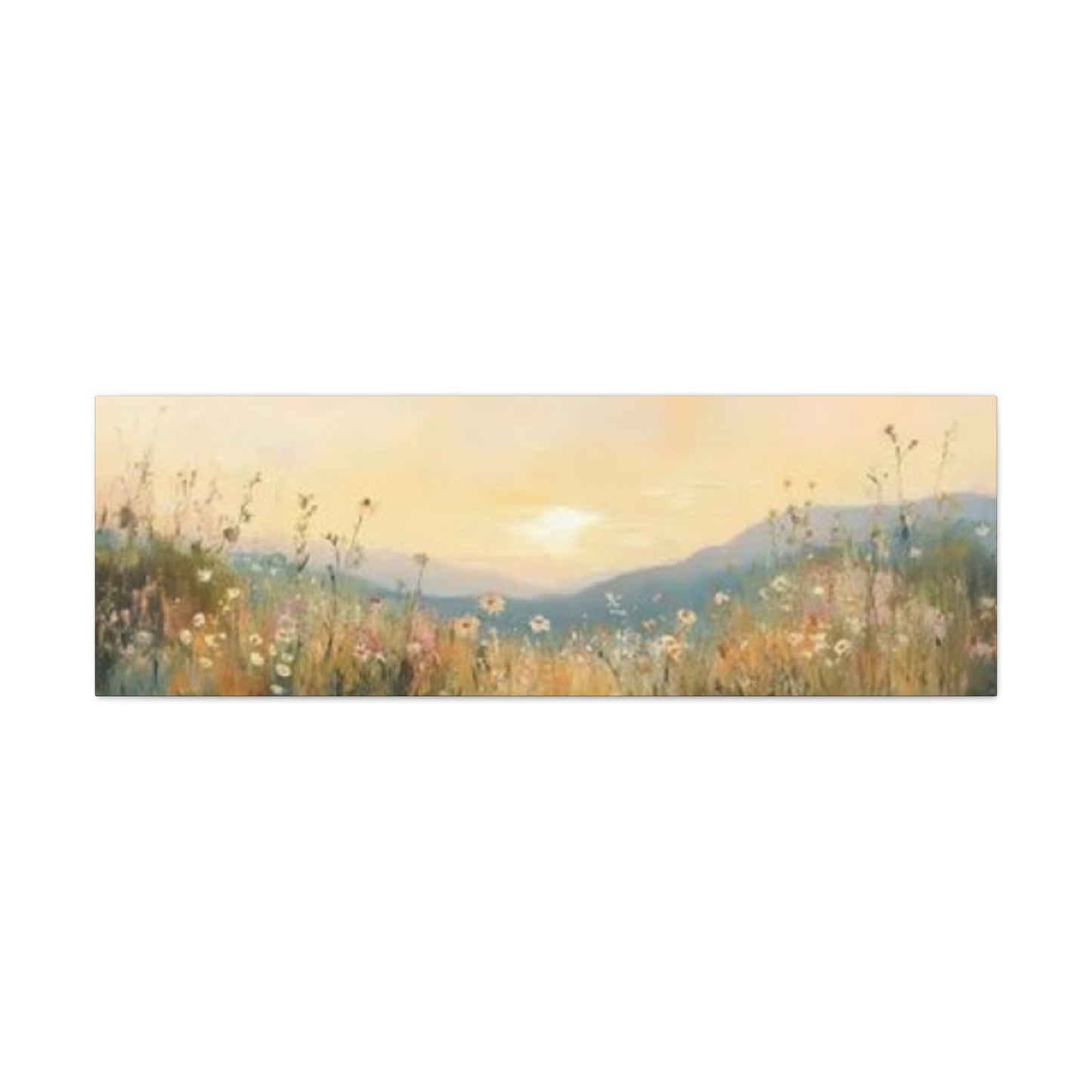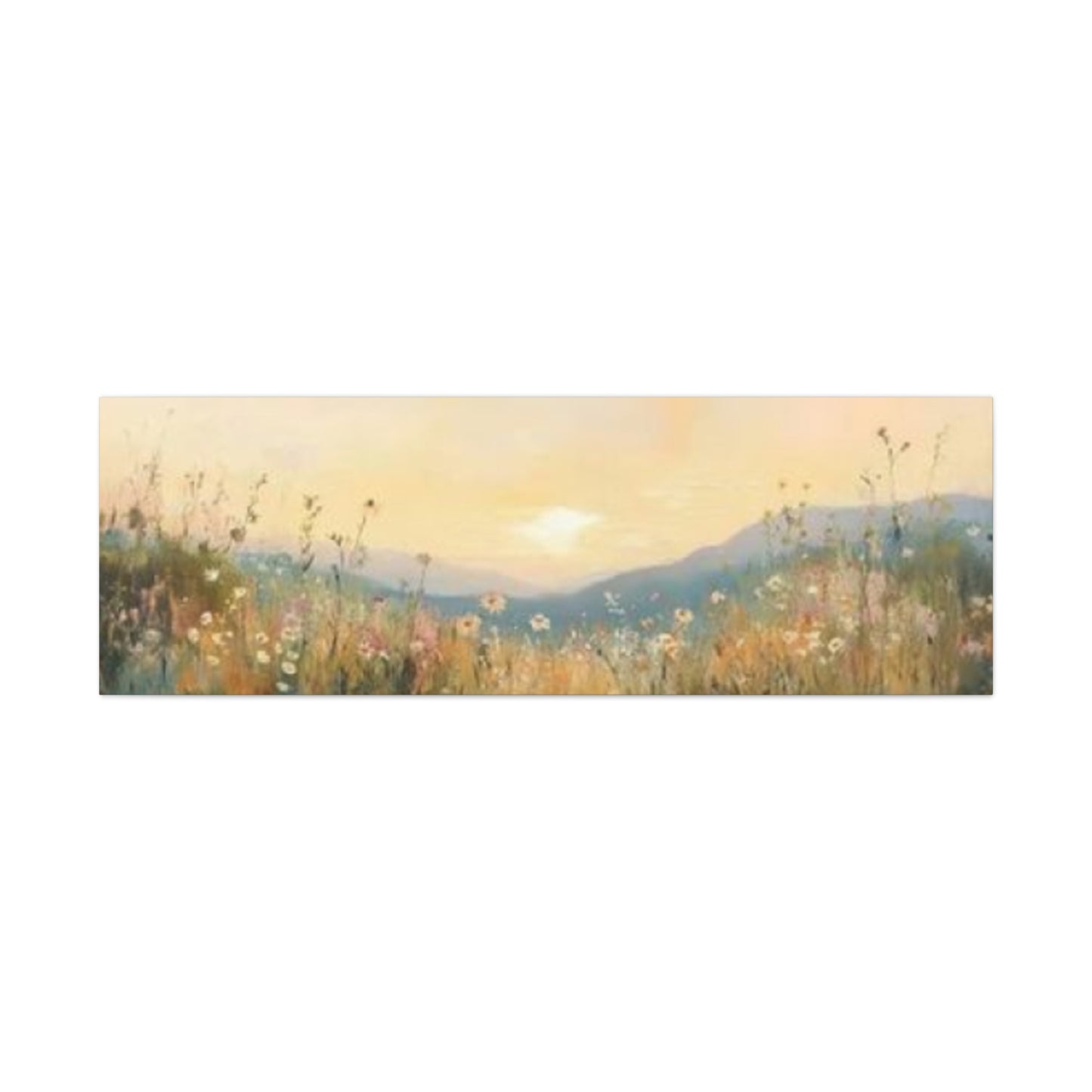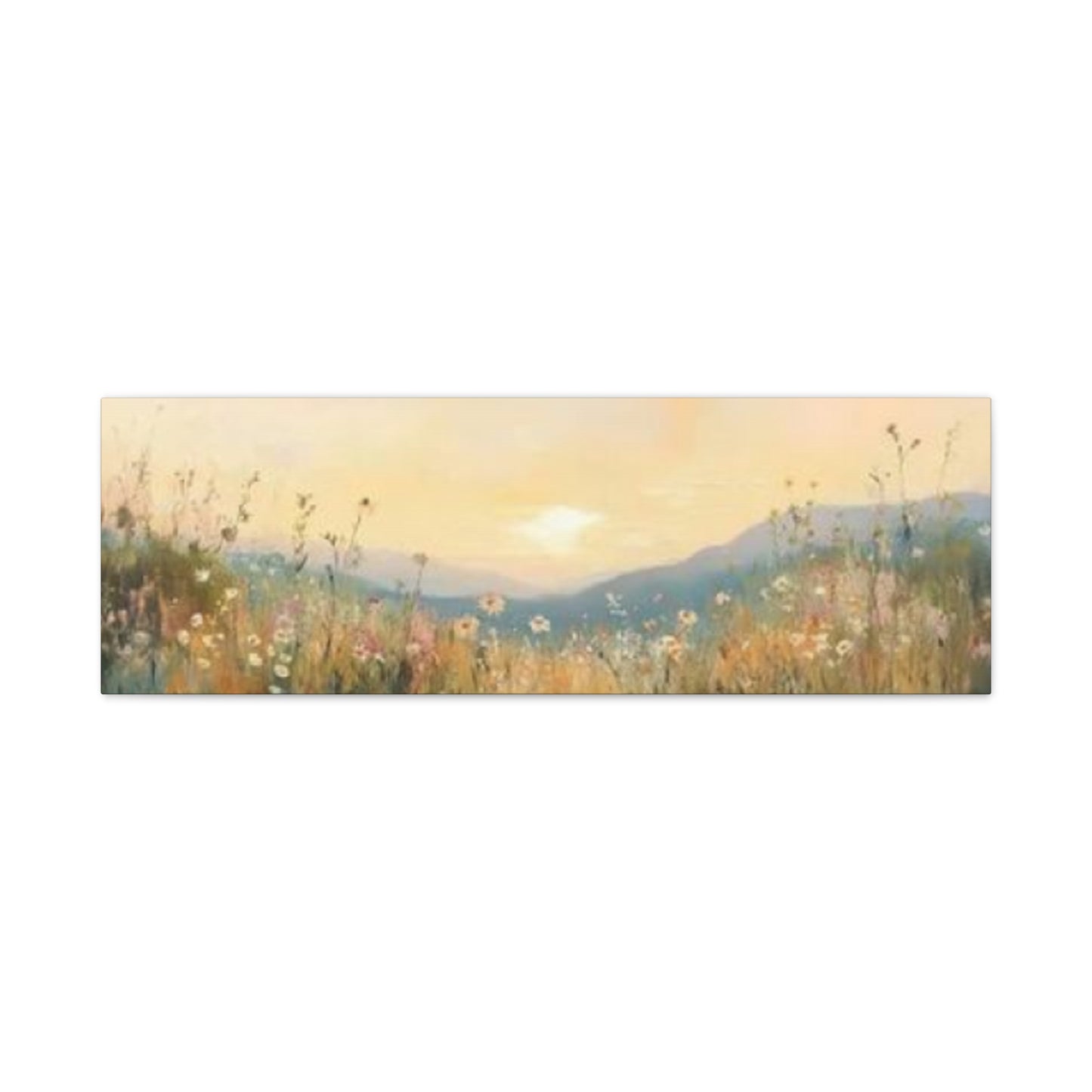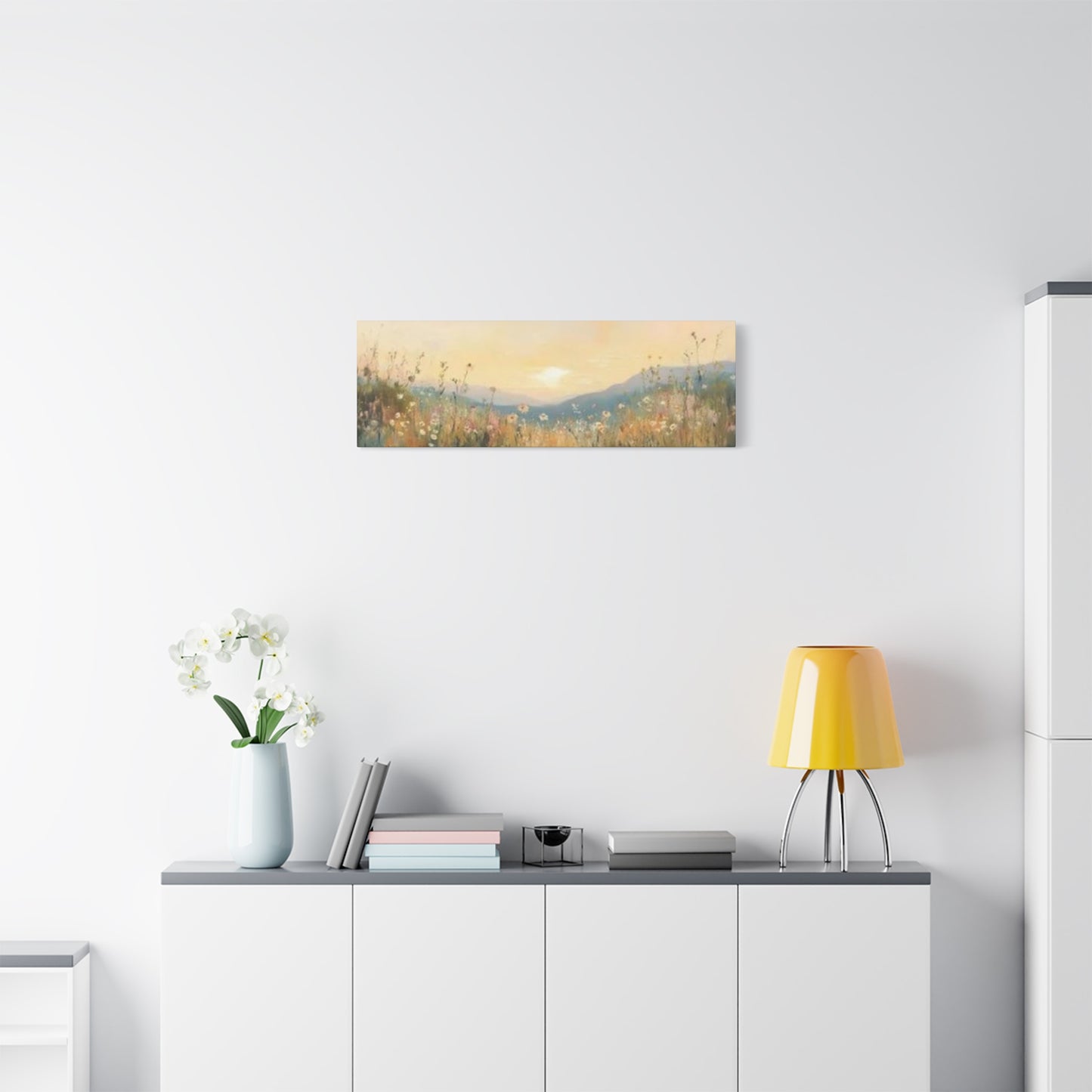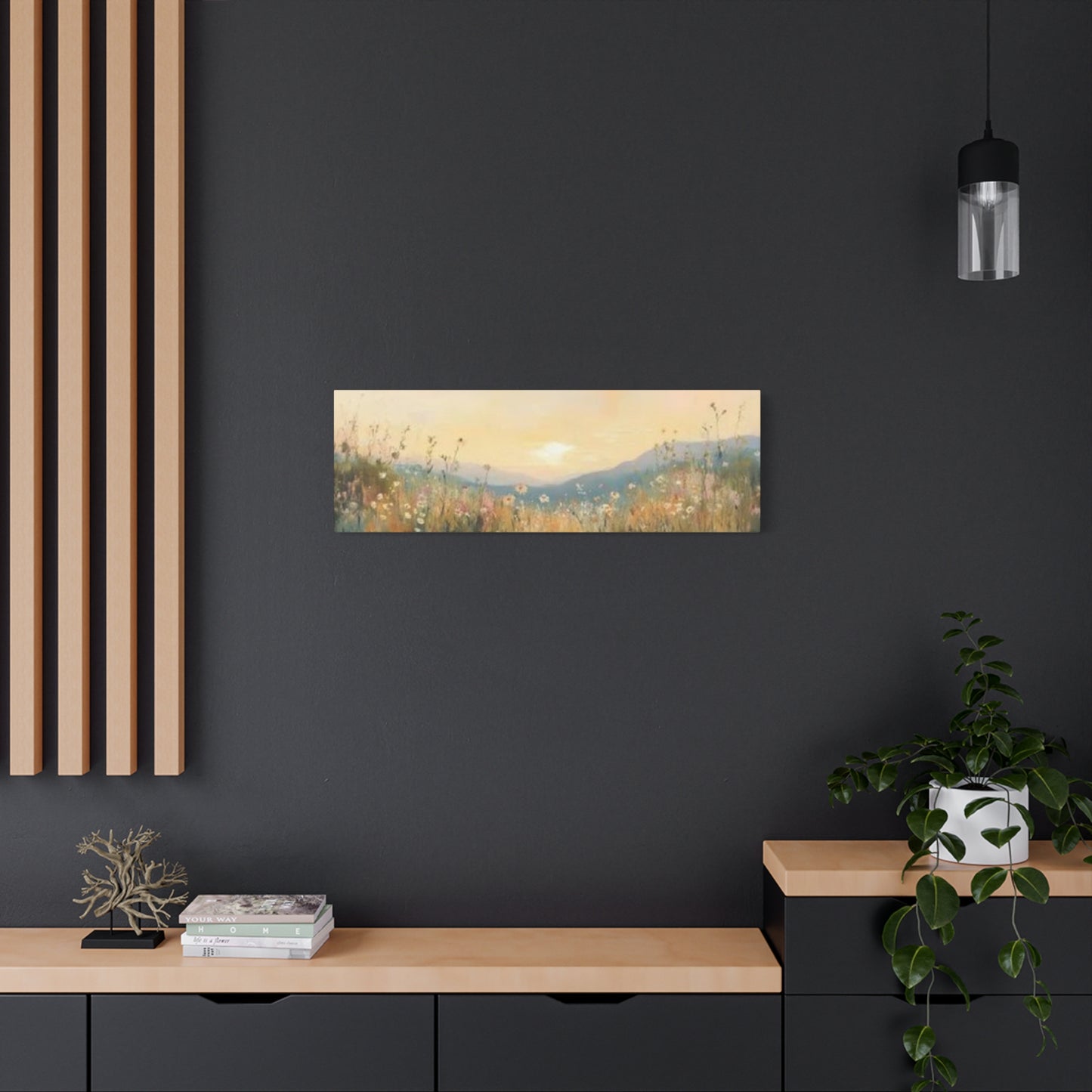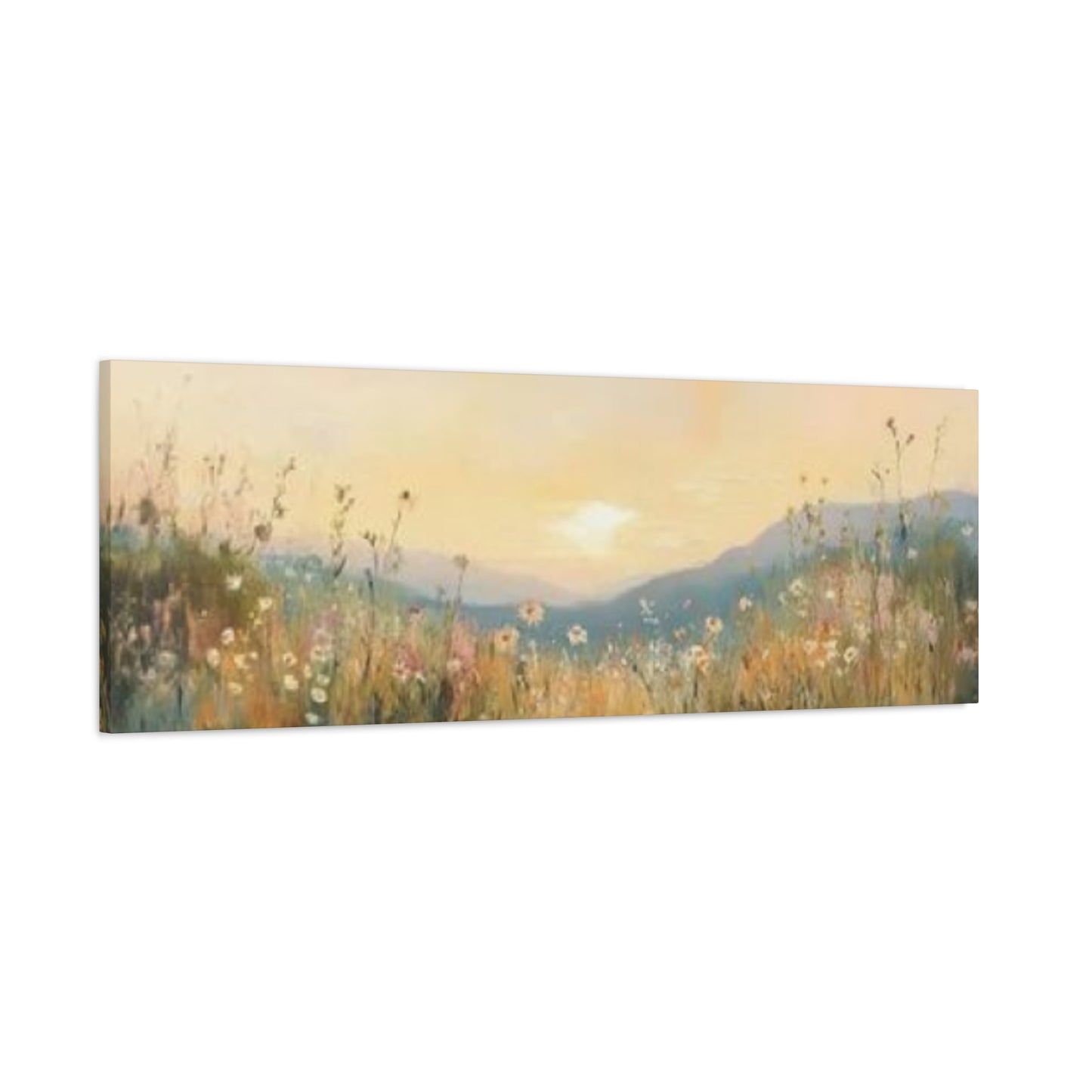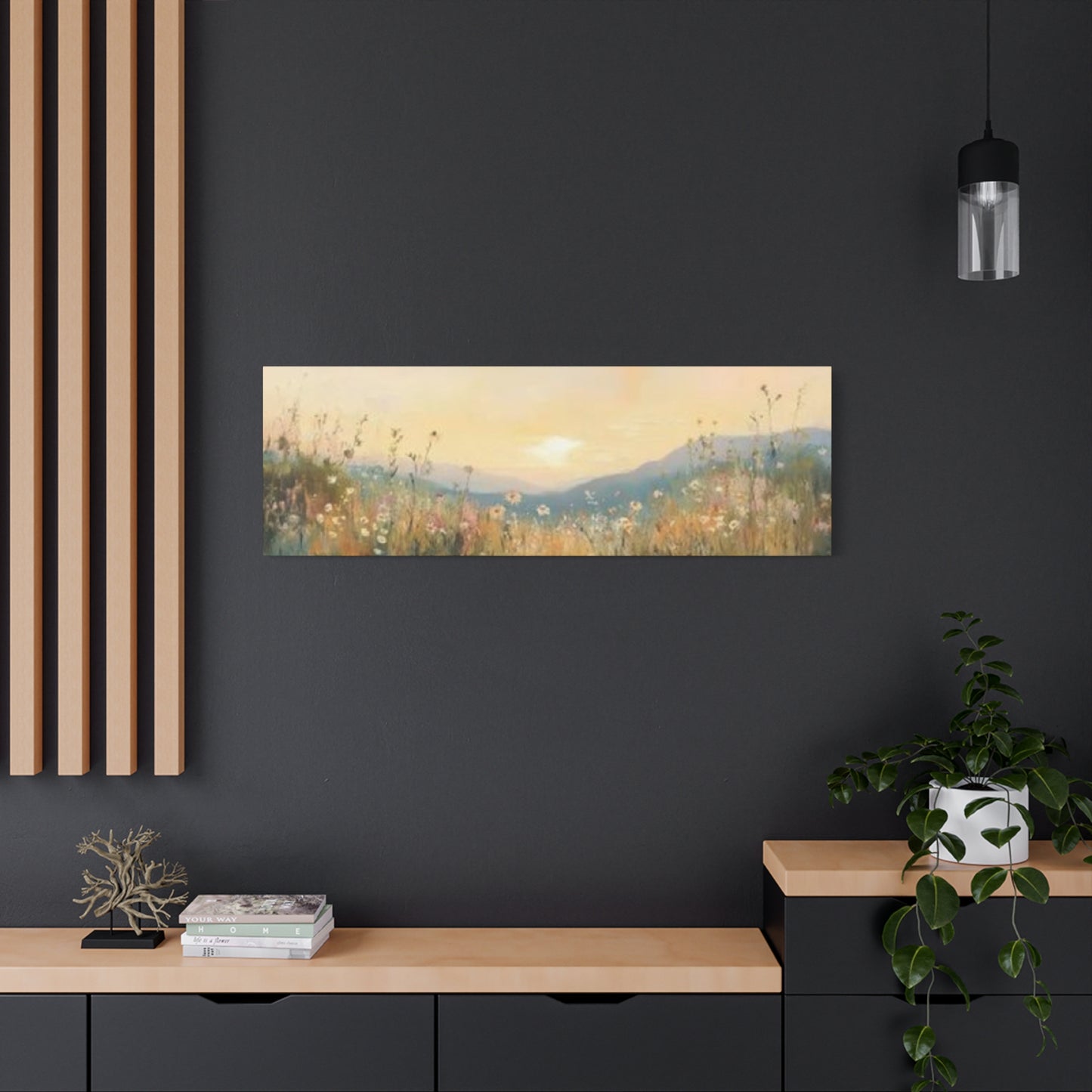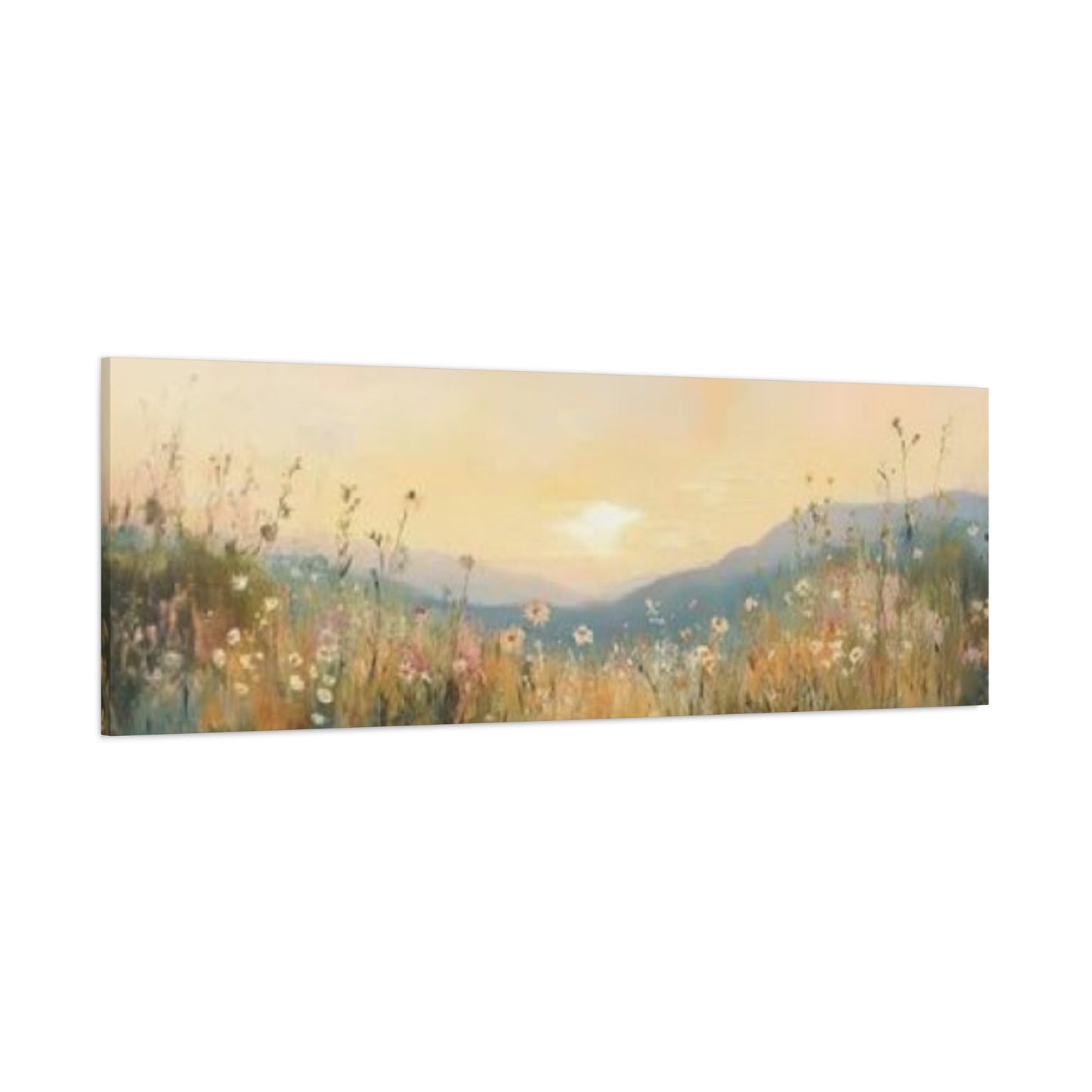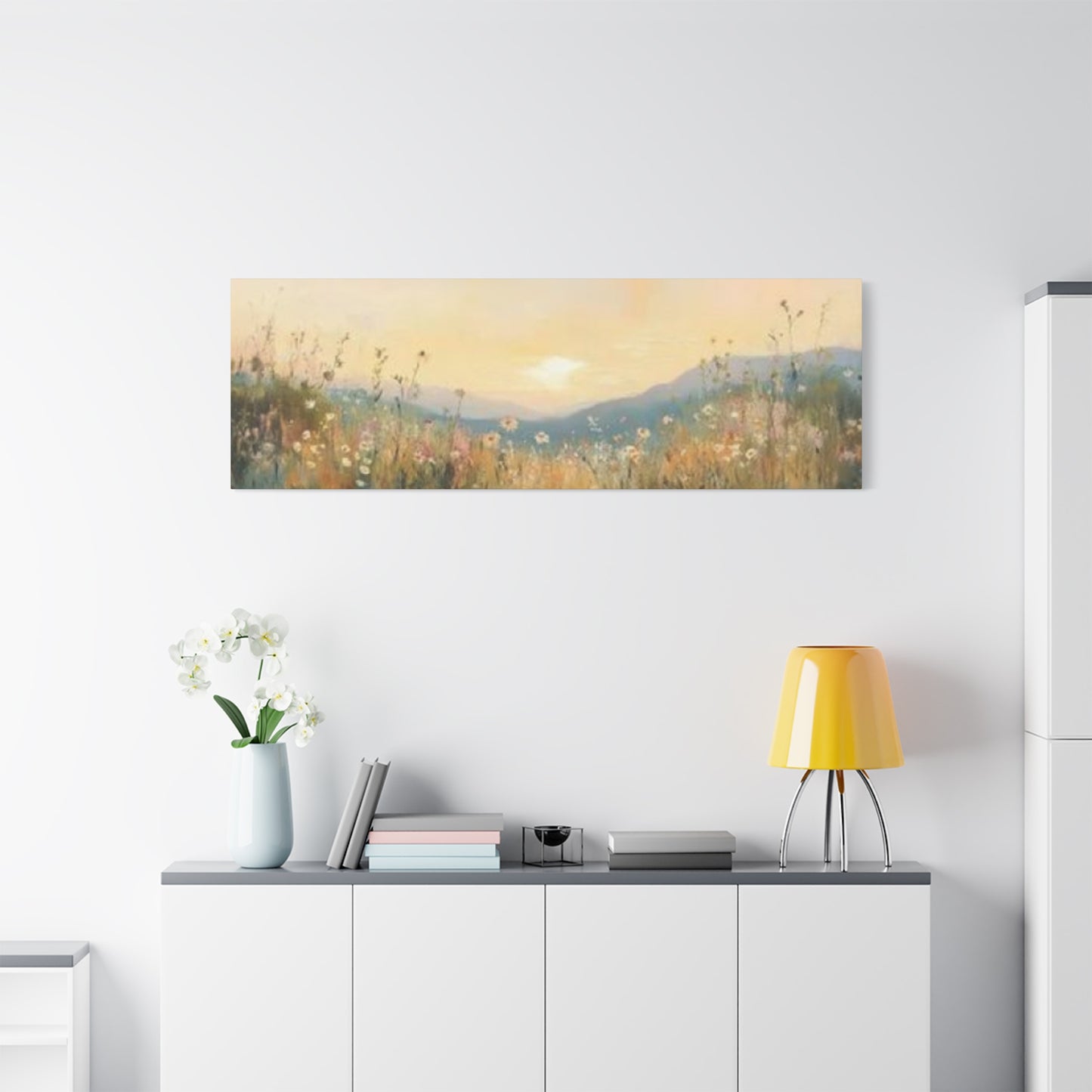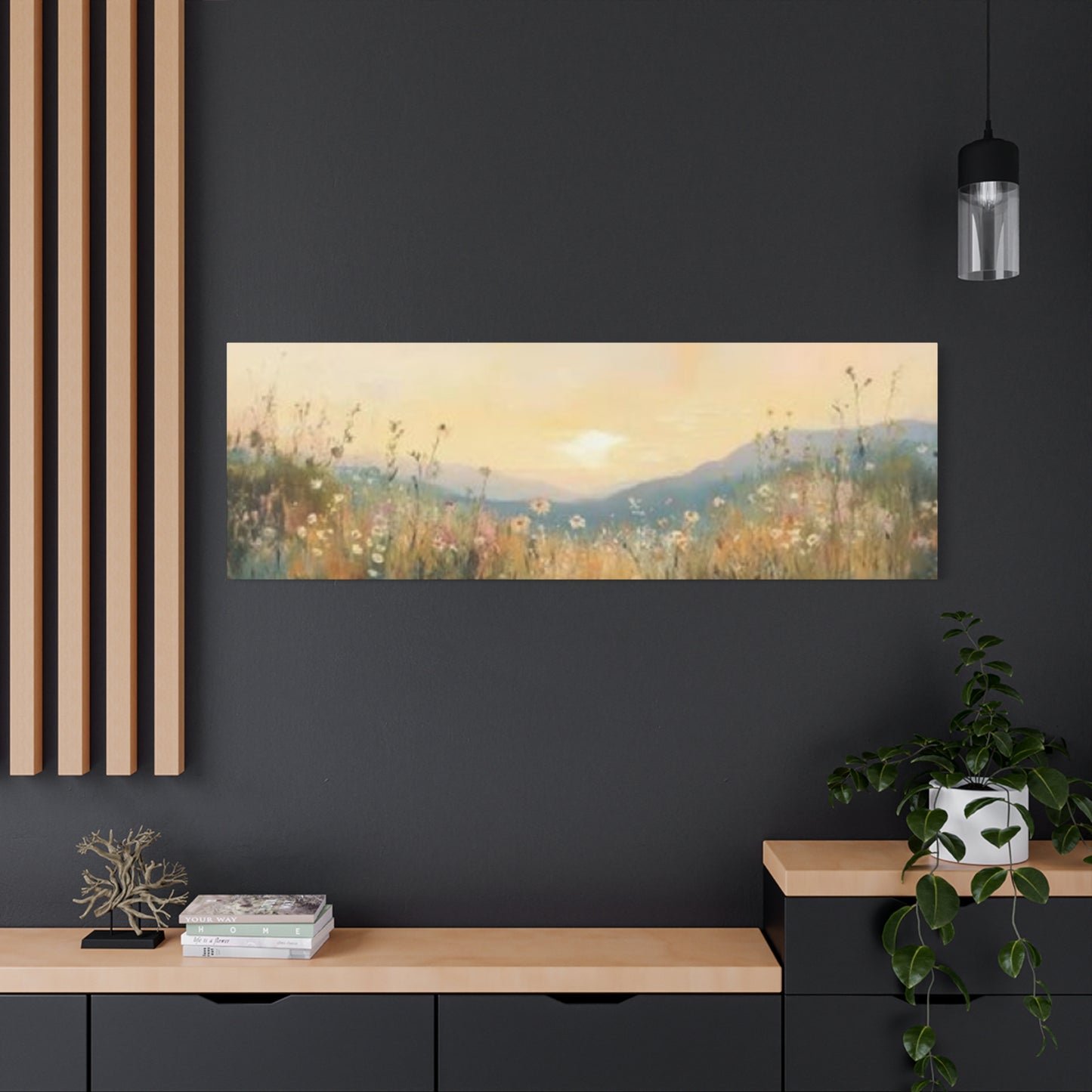Mountain Sunset Panorama Wall Art: Complete Guide to Canvas Prints and Display Ideas
Mountain sunset panoramas represent one of nature's most breathtaking spectacles, captured forever on canvas to bring that same awe-inspiring beauty into your home. These magnificent works transform any room into a sanctuary of natural wonder, offering a daily reminder of the majesty that exists in our world. Whether you're drawn to the fiery oranges and reds of a dramatic alpine evening or the soft pastels of a gentle mountain dusk, panoramic canvas prints offer an accessible way to own a piece of this natural artistry.
The appeal of mountain sunset panoramas goes far beyond simple decoration. These pieces carry with them the essence of adventure, tranquility, and the timeless beauty of untouched wilderness. They serve as windows to distant peaks, inviting contemplation and providing a visual escape from the demands of daily life. For nature enthusiasts, travelers, and anyone who finds solace in natural beauty, these artworks become more than just decoration; they become companions that inspire and rejuvenate.
Capturing Panoramic Mountain Sunsets on Canvas
The process of translating a mountain sunset into canvas form requires both technical skill and artistic sensitivity. Photographers and painters who specialize in this genre must possess an intimate understanding of how light behaves at high elevations, how atmospheric conditions affect color perception, and how to compose a scene that captures the full drama of the moment. When a photographer stands before a mountain range at sunset, they're not just recording an image; they're making countless decisions about exposure, framing, and timing that will determine whether the final canvas truly captures the majesty of the scene.
Professional photographers often spend days or even weeks scouting locations, studying weather patterns, and waiting for the perfect convergence of conditions. They understand that exceptional mountain sunset photography isn't about luck; it's about preparation, patience, and a deep knowledge of how natural light interacts with terrain. The best panoramic shots often require specialized equipment, including wide-angle lenses that can capture the full breadth of a mountain range while maintaining sharpness from foreground to background. Many photographers use graduated neutral density filters to balance the bright sky with the darker mountain silhouettes, ensuring that both elements retain their visual impact in the final image.
The technical challenges of capturing mountain sunsets are considerable. The dynamic range between the brilliant sunset sky and the shadowed mountains can exceed what even the most advanced cameras can record in a single exposure. This is why many professional mountain sunset photographs are actually composites of multiple exposures, carefully blended to preserve detail in both highlights and shadows. The photographer must also work quickly, as the most spectacular sunset colors often last for only a few minutes. The famous "golden hour" can be surprisingly brief at high elevations, where the sun disappears behind peaks quickly and decisively.
Digital processing plays a crucial role in translating raw camera files into finished canvas prints. Skilled artists use sophisticated software to enhance colors, adjust contrast, and bring out details that were present in the scene but might not have been fully captured in the original exposure. However, the best practitioners maintain a delicate balance, enhancing the image's impact without crossing the line into unrealistic exaggeration. The goal is to create a canvas that faithfully represents the emotional truth of the moment, even if it requires some technical manipulation to achieve that representation.
Painters who work directly in the medium of mountain sunsets face different but equally significant challenges. They must translate three-dimensional reality onto a two-dimensional surface using only paint and technique. Many artists work from photographs, but the most compelling pieces often come from those who have personally experienced the scenes they paint. There's an authenticity that comes from having stood in the cold mountain air, felt the wind on your face, and witnessed firsthand how quickly the light changes as the sun approaches the horizon. These artists bring not just visual memory but emotional memory to their work, infusing their paintings with a sense of presence that purely photograph-based work sometimes lacks.
The choice between photographic prints and painted canvases often comes down to personal preference and the specific aesthetic you're trying to achieve. Photographic panoramas offer incredible detail and realism, allowing viewers to see every ridge, every tree, and every cloud with perfect clarity. Painted versions, on the other hand, offer interpretation and artistic license. They can emphasize certain elements, simplify others, and create mood through brushwork and color choices that photography cannot easily replicate. Some collectors appreciate having both types in their collections, recognizing that each medium offers unique strengths and appeals to different aspects of our visual appreciation.
Modern printing technology has revolutionized the accessibility of high-quality mountain sunset panoramas. Advanced giclée printing processes can reproduce photographs and paintings with extraordinary fidelity, using archival inks that resist fading for decades. These prints are produced on museum-quality canvas, stretched over sturdy wooden frames that keep the fabric taut and prevent warping over time. The result is a product that rivals the quality of much more expensive original works, making it possible for anyone to own gallery-worthy mountain sunset panoramas without the premium price tag that accompanies one-of-a-kind pieces.
Vibrant Hues in Mountain Sunset Panoramas
The color palette of mountain sunsets represents one of nature's most spectacular performances, ranging from subtle pastels to explosively vibrant crimsons and golds. These hues result from complex atmospheric physics, as sunlight passes through increasingly thick layers of atmosphere at low angles, scattering shorter wavelengths and allowing longer red and orange wavelengths to dominate. At high elevations, where the air is thinner and clearer, these colors can achieve an intensity that seems almost artificial, yet is entirely natural. The particles suspended in the atmosphere, including dust, pollen, and water vapor, act as natural filters and reflectors, creating the conditions for truly spectacular color displays.
When translated to canvas, these vibrant hues become the emotional heart of the piece. A mountain sunset panorama dominated by warm tones creates feelings of comfort, energy, and optimism. The oranges and reds stimulate the senses and command attention, making such pieces natural focal points in any room. These warm-toned panoramas work exceptionally well in living rooms, dining areas, and other gathering places where their energy can enhance social interaction and create an inviting atmosphere. The psychological impact of these colors is well-documented; warm hues are associated with feelings of warmth, passion, and vitality, making them popular choices for people who want their artwork to energize and uplift.
Conversely, mountain sunsets that emphasize cooler tones create entirely different moods. When purple, blue, and violet dominate the sky, the feeling shifts toward tranquility, mystery, and introspection. These cooler palettes are often seen in high-altitude sunsets or in scenes captured after the sun has fully set, during the period photographers call the "blue hour." The soft, diffused light of this time creates subtle gradations of color that can be extraordinarily beautiful in their restraint. Such panoramas work wonderfully in bedrooms, meditation areas, and private offices where calm and concentration are valued over stimulation and energy.
The most dramatic mountain sunset panoramas often feature a combination of warm and cool tones, creating visual tension and interest through color contrast. A canvas might show brilliant oranges and reds in the western sky where the sun is setting, while the eastern sky displays cooler purples and blues. The mountains themselves might be rendered in deep blues and purples as they fall into shadow, creating a striking contrast with the brilliant sky behind them. This interplay of warm and cool creates depth and dimension, guiding the viewer's eye through the composition and creating a more engaging visual experience than single-tone palettes typically provide.
The intensity of colors in mountain sunset panoramas also varies dramatically based on atmospheric conditions. Clear, dry air produces relatively subtle sunsets with gentle color gradations. However, when the atmosphere contains more particles, whether from distant wildfires, volcanic activity, or simply increased humidity, the colors can become almost overwhelming in their intensity. Some of the most famous and sought-after mountain sunset photographs were captured during periods of unusual atmospheric conditions, when skies turned shades of red and orange so intense they barely seemed real. These extraordinary moments, frozen on canvas, become conversation pieces and sources of perpetual fascination.
Artists and photographers have long understood that color choices in mountain sunset panoramas extend beyond simple documentation of what was present in the original scene. Even when working from photographs, painters make deliberate choices about which colors to emphasize, which to subdue, and how to balance the overall palette to achieve the desired emotional effect. Some artists push their colors toward greater saturation, creating bold, almost graphic interpretations of mountain sunsets. Others work in more muted palettes, creating contemplative pieces that whisper rather than shout. Neither approach is inherently superior; they simply serve different purposes and appeal to different sensibilities.
The technical aspects of reproducing vibrant hues on canvas present their own challenges. Print shops must calibrate their equipment carefully to ensure that the colors displayed on computer screens match the colors that appear on the finished canvas. This is more difficult than it might seem, as screens emit light while canvas reflects it, creating fundamental differences in how colors appear. Professional printing services invest heavily in color management systems, using specially designed viewing environments and regular calibration to ensure consistent, accurate color reproduction. When you purchase a high-quality mountain sunset panorama, you're benefiting from this technical expertise, receiving a product whose colors closely match the artist's or photographer's original vision.
The Grandeur of Mountain Ranges at Sunset
Mountain ranges possess an inherent majesty that becomes even more pronounced when silhouetted against a sunset sky. The sheer scale of these geological formations, the result of millions of years of tectonic forces and erosion, creates a sense of timelessness and permanence that resonates deeply with viewers. When captured in panoramic format during the sunset hour, mountain ranges become monuments to nature's power and beauty, reminding us of our place within a much larger natural world. The horizontal format of panoramic images emphasizes the vast sweep of mountain chains, allowing viewers to appreciate both individual peaks and the overall rhythm of the landscape.
Different mountain ranges possess distinct characteristics that make them immediately recognizable to those familiar with their profiles. The jagged, dramatic peaks of the Rockies differ markedly from the rounded, ancient summits of the Appalachians. The Alps present yet another profile, with their sharp, snow-capped peaks rising dramatically above treelines. These distinctive characteristics translate into equally distinctive sunset panoramas, each with its own visual signature and emotional resonance. Collectors often develop preferences for particular mountain ranges, either because they've visited them personally or because the visual characteristics of those mountains align with their aesthetic preferences.
The way light interacts with mountain topography during sunset creates constantly changing patterns of highlight and shadow. Peaks that catch the last rays of direct sunlight seem to glow with an inner fire, while valleys and canyons descend into deep shadow. This dramatic contrast, known as chiaroscuro in artistic terminology, adds depth and dimension to mountain panoramas. The interplay between light and dark creates a three-dimensional quality that helps viewers understand the complex topography of the scene. Without this contrast, mountain ranges can appear flat and lifeless; with it, they become dynamic and engaging, inviting extended contemplation.
The elevation and prominence of mountain ranges also affect how they appear at sunset. Higher peaks often remain illuminated longer than surrounding terrain, creating the phenomenon known as alpenglow, where mountains seem to radiate warm, pink light even after the sun has set. This effect, caused by indirect sunlight reflecting off high-altitude peaks, creates some of the most ethereal and memorable mountain sunset images. Photographers who specialize in mountain panoramas often plan their shoots specifically to capture alpenglow, knowing that this brief period produces colors and lighting conditions unavailable at any other time.
The grandeur of mountain ranges at sunset also encompasses the foreground elements that provide context and scale. A mountain panorama that includes forests, meadows, or lakes in the foreground creates a more complete narrative, showing the full ecosystem that surrounds these peaks. These foreground elements help viewers understand the massive scale of the mountains by providing familiar reference points. A grove of trees, barely visible at the base of a peak, reminds us just how enormous these mountains truly are. Similarly, a lake reflecting the sunset colors adds an additional dimension to the composition, creating a sense of balance and completeness that pure mountain-and-sky compositions sometimes lack.
Seasonal variations add another layer of interest to mountain range panoramas. The same range photographed in summer, autumn, winter, and spring can look dramatically different, offering collectors the opportunity to own multiple versions of the same basic scene, each with its own character. Summer mountain sunsets might feature lush green forests and wildflower-covered meadows. Autumn brings golden aspens and larches, their foliage echoing the warm colors of the sunset sky. Winter transforms mountains into stark, minimalist compositions of snow, rock, and sky. Spring offers the promise of renewal, with snow beginning to retreat and the first hints of green returning to the landscape. Each season offers its own interpretation of mountain grandeur at sunset.
The emotional response to mountain range panoramas at sunset is nearly universal, transcending cultural boundaries and personal backgrounds. There's something fundamental in the human psyche that responds to mountains, perhaps because they represent challenge, achievement, and perspective. When we look at mountain panoramas, we're reminded of our own journeys, our own obstacles overcome, and our own aspirations. The sunset adds layers of meaning related to endings, transitions, and the cyclical nature of time. Together, mountains and sunsets create powerful symbols that speak to deep aspects of the human experience, which helps explain why these images remain perennially popular in both art and decoration.
Small Versus Large Mountain Sunset Canvas Prints
The decision between small and large mountain sunset canvas prints involves multiple considerations, from practical concerns about available wall dimensions to aesthetic questions about visual impact and viewing distance. Small prints, typically ranging from twelve to thirty inches in their longest dimension, offer affordability, flexibility, and ease of installation. They work well in intimate settings, on gallery walls alongside other artwork, and in situations where budget constraints make larger pieces impractical. Despite their modest size, high-quality small prints can deliver significant visual impact, especially when viewed from appropriate distances in smaller rooms.
Small mountain sunset panoramas excel in creating cohesive gallery wall arrangements. By combining multiple smaller prints, you can create a larger overall composition that offers variety and visual interest impossible to achieve with a single large piece. This approach allows you to mix different mountain ranges, different times of day, or different artistic interpretations while maintaining thematic consistency. The flexibility of gallery walls also means you can easily update or reorganize your display without the commitment and expense associated with large statement pieces. For renters or people who frequently redecorate, this flexibility represents a significant advantage.
However, small prints have inherent limitations when it comes to capturing the full grandeur of mountain sunset panoramas. The panoramic format, with its wide aspect ratio, becomes challenging to appreciate when reduced to small dimensions. Details that would be clearly visible in larger prints become difficult to discern, and the sense of immersion that makes panoramic mountain sunsets so compelling can be diminished. A small panoramic print of a vast mountain range might fail to convey the scale and majesty of the scene, reducing what should be an awe-inspiring vista to something more decorative than impactful.
Large mountain sunset canvas prints, typically ranging from forty inches to eighty inches or more in width, offer an entirely different experience. These substantial pieces command attention and can transform entire rooms, becoming the dominant visual element around which other design choices revolve. When executed well, large panoramic prints create a sense of immersion, making viewers feel as though they're standing before an actual window overlooking the mountain range. This scale is particularly effective for open-concept living areas, large bedrooms, and office environments where smaller pieces would be visually lost.
The impact of scale on emotional response should not be underestimated. Research in environmental psychology suggests that larger nature images produce stronger positive emotional responses than smaller versions of the same images. The mechanism behind this effect appears to be related to our field of vision; larger images occupy more of our visual field, creating a more immersive experience that triggers stronger emotional and physiological responses. For people seeking the therapeutic and mood-enhancing benefits of nature imagery, investing in larger prints may produce measurably better results than purchasing multiple smaller pieces.
Large panoramic mountain sunset prints do present practical challenges. They require careful measurement and often professional installation to ensure proper mounting and leveling. The weight of large stretched canvases necessitates appropriate wall anchors and hardware; standard picture hooks will not suffice for pieces weighing twenty or thirty pounds. Shipping costs for large prints are also considerably higher than for small pieces, and the risk of damage during transit increases with size. These practical considerations mean that large prints represent a more significant investment of both money and effort than their smaller counterparts.
The viewing distance appropriate for different print sizes also affects their effectiveness in various settings. Small prints benefit from close viewing, allowing observers to appreciate fine details and subtle color gradations. Large prints, conversely, need viewing distance to be properly appreciated; standing too close to a very large panoramic print can actually diminish the impact, as viewers cannot take in the entire composition at once. This is why large mountain sunset panoramas work best in rooms where viewers will typically be at least eight to twelve feet away from the artwork. In smaller rooms, modest-sized prints may actually provide a better viewing experience despite their reduced scale.
The aspect ratio of panoramic mountain sunset prints becomes increasingly important as size increases. A true panoramic format, typically with an aspect ratio of two-to-one or even three-to-one, emphasizes the horizontal sweep of mountain ranges and sunset skies. These ultra-wide formats work beautifully above sofas, beds, and long console tables, where their proportions complement the horizontal lines of the furniture. However, these same proportions can be challenging to integrate into rooms with abundant vertical elements or limited horizontal wall lengths. Understanding the relationship between print proportions and the architectural features of your room is essential for selecting the right size mountain sunset panorama.
Budget considerations inevitably play a role in size selection. Large, high-quality mountain sunset canvas prints represent significant investments, often costing several hundred dollars or more. For the same budget, you could purchase multiple smaller prints, potentially creating a more varied and personally interesting collection. The question becomes whether you prefer the impact of a single powerful statement piece or the flexibility and variety of multiple smaller works. Neither approach is objectively superior; the right choice depends on your personal preferences, your space, and how you interact with visual art in your environment.
Caring for Mountain Panorama Sunset Art
Proper care and maintenance of mountain panorama sunset canvas prints ensures they remain vibrant and beautiful for many years, potentially decades. Unlike framed prints behind glass, canvas prints are exposed to environmental conditions, making them more vulnerable to dust, dirt, and damage. However, with appropriate care, high-quality canvas prints prove remarkably durable and can maintain their visual impact with minimal intervention. Understanding the factors that affect canvas longevity helps owners protect their investments and enjoy their mountain sunset panoramas for years to come.
Dust accumulation represents the most common maintenance challenge for canvas prints. Over time, airborne particles settle on the canvas surface, dulling colors and reducing visual clarity. Regular gentle dusting with a soft, dry cloth or a feather duster prevents buildup and keeps the print looking fresh. The key is using light pressure and soft materials; abrasive cloths or vigorous rubbing can damage the canvas surface or disturb the printed ink layer. For particularly stubborn dust accumulation, a very slightly damp microfiber cloth can be used, though care must be taken to ensure no water soaks into the canvas or reaches the wooden stretcher frame, which could cause warping or mold growth.
Light exposure poses the most significant long-term threat to canvas print longevity. All printed materials fade when exposed to light, particularly direct sunlight containing ultraviolet radiation. High-quality mountain sunset panoramas printed with archival inks and protective coatings resist fading much better than lower-quality alternatives, but even the best prints will eventually show degradation if exposed to intense light for extended periods. The solution is strategic placement; avoid hanging canvas prints where direct sunlight strikes them, particularly during the intense midday hours. If your ideal display location receives significant natural light, consider UV-filtering window treatments that block harmful radiation while still allowing visible light to enter the room.
Temperature and humidity fluctuations also affect canvas print longevity. Extreme conditions cause the canvas fabric to expand and contract, potentially leading to warping, sagging, or separation from the stretcher frame. Maintain your canvas prints in climate-controlled environments where temperature remains relatively stable and humidity stays within a moderate range, ideally between forty and sixty percent relative humidity. Avoid displaying canvas prints in bathrooms, kitchens, or other areas where humidity levels fluctuate dramatically. Similarly, avoid locations near heating vents, fireplaces, or air conditioning units that create localized temperature extremes.
Protective coatings applied to canvas prints during manufacturing provide an additional layer of defense against environmental challenges. These coatings, typically UV-resistant varnishes or laminates, create a barrier between the printed image and the environment, helping to prevent fading, resist moisture, and make cleaning easier. When purchasing mountain sunset panoramas, inquire about the protective coatings used; this feature, while sometimes overlooked, significantly impacts the long-term durability of the print. Some manufacturers offer multiple coating options, allowing buyers to choose between matte, satin, or gloss finishes based on their aesthetic preferences and the lighting conditions in the display environment.
Physical damage prevention requires awareness and occasional vigilance. Canvas prints lack the protective glass layer of traditional framed artwork, making them vulnerable to punctures, tears, and scratches. Position canvas prints away from high-traffic areas where they might be bumped or struck. If you have pets, particularly cats that might be tempted to use canvas as a scratching surface, consider placement carefully or use deterrents. Small children also pose risks; consider waiting to display valuable canvas prints until children are old enough to understand that artwork should not be touched. While minor damage to canvas can sometimes be repaired by professionals, prevention remains the best strategy.
Regular inspection helps identify developing problems before they become serious. Every few months, examine your mountain sunset panoramas for signs of fading, particularly if they're displayed in bright rooms. Look for any sagging or warping of the canvas, which might indicate humidity problems or inadequate stretching. Check the back of the canvas for any signs of mold or mildew, which appear as dark spots or a musty odor. Addressing these issues early prevents more serious damage and potentially saves the print. If you notice significant problems, consult with a professional art conservator rather than attempting DIY repairs that might cause additional damage.
Professional cleaning becomes necessary when regular dusting proves insufficient or when the canvas has been exposed to smoke, cooking odors, or other contaminants that affect its appearance or smell. Some canvas prints can be gently cleaned with specialized art cleaning products, but this work is best left to professionals who understand the chemistry of canvas and inks. Attempting to deep-clean a canvas print without proper knowledge and materials risks permanent damage. If your mountain sunset panorama requires more than routine dusting, contact the retailer where you purchased it or seek out a local art restoration specialist for guidance.
Storage of canvas prints, when necessary, requires careful attention to prevent damage. If you need to store a mountain sunset panorama temporarily, protect it with acid-free paper or bubble wrap, never allowing plastic to contact the printed surface directly, as this can cause image transfer or damage to the protective coating. Store the wrapped canvas in a climate-controlled environment, away from temperature extremes and humidity. If possible, store canvases upright rather than flat, as stacking can create pressure points that cause impressions in the canvas. Never store canvas prints in basements, attics, or garages where temperature and humidity fluctuate dramatically and where pests might cause damage.
Framing Ideas for Mountain Sunset Panoramas
While many mountain sunset panoramas are sold as gallery-wrapped canvases that require no additional framing, adding frames to these pieces can enhance their visual impact, better integrate them with your existing décor, and provide additional protection. The decision to frame or not to frame depends on personal aesthetic preferences, the style of the artwork, and the environment in which it will be displayed. Understanding the various framing options available helps you make choices that enhance rather than detract from the beauty of your mountain sunset panoramas.
Floating frames represent one of the most popular framing options for canvas prints. These frames attach to the edges of the stretched canvas, creating a border that appears to float around the image. The canvas itself remains visible from the sides, maintaining the modern, clean look of gallery-wrapped pieces while adding definition and visual weight. Floating frames come in various materials, including wood, metal, and composite materials, each offering different aesthetic qualities. Natural wood floating frames complement the organic subject matter of mountain sunsets, creating visual harmony between the frame and the image. The grain and color of the wood can be selected to either match or contrast with the dominant tones in the sunset panorama.
Black floating frames offer a classic, sophisticated look that works well with virtually any mountain sunset palette. The neutral black creates a strong boundary between the artwork and the wall, helping the image pop visually while maintaining a contemporary aesthetic. Black frames particularly suit mountain sunset panoramas with dramatic contrast and bold colors, emphasizing the intensity of the scene. They also work exceptionally well in modern or minimalist interiors where ornate framing would feel out of place. The simplicity of a black floating frame ensures that attention remains focused on the artwork rather than being diverted to decorative frame elements.
White and light-colored floating frames create an entirely different effect, providing a soft, airy border that can make mountain sunset panoramas feel lighter and more ethereal. These frames work beautifully with sunset images that emphasize pastel tones and gentle color transitions. In rooms with predominantly light-colored walls and furnishings, white or natural wood frames help integrate the artwork into the overall design scheme without creating harsh contrasts. Light-colored frames are particularly effective in Scandinavian-inspired or coastal design schemes, where the goal is to maintain a sense of openness and connection to natural light.
Metallic frames, including gold, silver, bronze, and copper finishes, add a touch of elegance and luxury to mountain sunset panoramas. These frames work particularly well with sunset images featuring warm tones; a gold or bronze frame can echo the golden light of the sunset, creating visual continuity between the frame and the image. However, metallic frames must be chosen carefully to avoid overwhelming the artwork or creating a dated appearance. Modern metallic frames with clean lines and minimal ornamentation tend to work better than heavily decorated traditional styles, which can compete with the natural beauty of the mountain sunset rather than complementing it.
Shadow box framing creates significant depth by mounting the canvas several inches away from the wall, creating a dramatic three-dimensional effect. This technique works spectacularly well with mountain sunset panoramas, as the added dimension emphasizes the sense of looking through a window into a distant landscape. Shadow box frames are more expensive and complex than standard floating frames, but the visual impact justifies the investment for those seeking maximum drama. The depth created by shadow box framing also provides practical benefits, as it increases air circulation around the canvas, potentially extending its lifespan by reducing exposure to wall moisture.
No-frame options remain popular among collectors who prefer the clean, modern aesthetic of gallery-wrapped canvas. These pieces feature the printed image wrapped around the edges of the stretcher frame, creating a finished appearance that requires no additional framing. This approach emphasizes the artwork itself and maintains a contemporary gallery feel. No-frame presentations work particularly well with minimalist interior design schemes and in situations where multiple canvases are displayed together, as frames can sometimes create visual clutter when many pieces are grouped. The cost savings of eliminating frames also makes this option attractive for budget-conscious collectors.
Custom framing opens up virtually unlimited possibilities for those willing to invest in truly unique presentations. Professional framers can create custom solutions that perfectly complement both the artwork and the room where it will be displayed. This might include creating frames from reclaimed wood that matches existing furniture, incorporating mat boards in colors drawn from the sunset palette, or designing frame profiles specifically proportioned for the dimensions of your particular mountain panorama. While custom framing represents a significant investment, it transforms good artwork into exceptional décor elements that appear professionally curated and intentionally integrated into your overall design.
The relationship between frame style and room décor cannot be overstated. A mountain sunset panorama in a rustic wooden frame might look perfect in a cabin or craftsman-style home but feel out of place in a modern loft with industrial design elements. Conversely, a sleek metal frame that looks stunning in a contemporary setting might clash with traditional furnishings and architectural details. Before selecting frames for your mountain sunset panoramas, consider the overall aesthetic of the room, including furniture style, color palette, and architectural features. The most successful framing choices create bridges between the artwork and its surroundings, helping both elements feel cohesive and intentional.
Using Light and Shadow in Mountain Sunsets
The interplay of light and shadow defines the visual character of mountain sunset panoramas, creating depth, drama, and emotional resonance. Understanding how artists and photographers manipulate these elements helps viewers appreciate the technical skill required to capture compelling mountain sunset images and make informed choices when selecting pieces for their collections. The contrast between illuminated peaks and shadowed valleys creates the three-dimensional quality that makes mountain panoramas feel alive and immersive rather than flat and decorative.
During the sunset hour, mountains experience rapidly changing lighting conditions that create constantly shifting patterns of light and shadow. As the sun descends toward the horizon, it strikes peaks at increasingly oblique angles, creating long shadows that stretch across valleys and emphasize every ridge, crevice, and geological feature. This dramatic sidelight reveals texture and form in ways that midday overhead light cannot, transforming mountains from simple silhouettes into complex, three-dimensional structures. Photographers who specialize in mountain sunsets understand these dynamics and position themselves to capture the moment when light and shadow achieve perfect balance.
The golden hour, that magical period shortly before sunset when sunlight takes on warm, honey-colored tones, represents the optimal time for mountain photography. During this brief window, typically lasting thirty to sixty minutes depending on latitude and season, sunlight travels through thick atmospheric layers that filter out cooler wavelengths, allowing warm oranges, reds, and golds to dominate. Mountains bathed in this golden light seem to glow with inner warmth, creating images that feel inviting and emotionally positive. The shadows during golden hour are softer and less harsh than midday shadows, maintaining detail in darker areas while still providing contrast and dimension.
Rim lighting, where the sun backlights mountain ridges, creates one of the most dramatic effects in mountain sunset photography. When viewed from certain angles, mountains appear outlined in brilliant light, with their main forms rendered as dark silhouettes against the brilliant sky. This technique emphasizes shape and profile over detail, creating graphic, almost abstract compositions that focus on the overall form of the mountain range rather than specific features. Rim-lit mountain panoramas possess a timeless, iconic quality that makes them popular choices for dramatic statement pieces in contemporary interiors.
The relationship between foreground shadows and background light creates powerful compositional tension in mountain sunset panoramas. Photographers often include foreground elements such as trees, rocks, or vegetation rendered in shadow, which serve as visual anchors and provide depth cues that help viewers understand the scale and distance of the scene. These shadowed foreground elements also create frames within the image, directing attention toward the illuminated mountains and sunset sky beyond. This layering of light and dark elements from foreground to background creates a sense of journey, inviting viewers to visually travel from the shadowed near elements into the brilliant distant landscape.
Chiaroscuro, the artistic technique of using strong contrasts between light and dark, reaches its natural zenith in mountain sunset photography. The term, borrowed from Renaissance painting, describes the dramatic interplay of illumination and shadow that creates mood, emphasis, and visual drama. In mountain sunsets, chiaroscuro isn't an artistic choice but a natural phenomenon, as the setting sun creates extreme contrasts between peaks that catch its rays and valleys that descend into deep shadow. Artists and photographers can emphasize or minimize these contrasts during processing, adjusting the relationship between highlights and shadows to achieve different emotional effects.
Shadow detail retention represents a key quality indicator in mountain sunset panoramas. Lower-quality prints may render shadowed areas as solid black, with no visible detail or tonal variation. Higher-quality pieces maintain subtle detail even in the darkest areas, allowing viewers to see gradations and textures within the shadows. This detail preservation creates richer, more sophisticated images that reward extended viewing. When evaluating potential purchases, examine the shadow areas carefully; if they appear as featureless black masses, the print may lack the quality necessary to justify its cost.
The direction and quality of light in mountain sunset panoramas also affect the mood and emotional character of the piece. Front lighting, where the sun illuminates the face of the mountains directly, creates relatively even, cheerful images with minimal shadow and good detail visibility. Side lighting emphasizes texture and dimension, creating more dramatic, contemplative pieces. Backlighting creates the most dramatic effects but sacrifices detail for impact, rendering mountains as silhouettes. Understanding these lighting styles helps collectors select pieces that align with the emotional tone they want to establish in their living areas.
Reflected light and indirect illumination add complexity and subtlety to sophisticated mountain sunset panoramas. Light bouncing off clouds, water, or snow can illuminate shadow areas with soft, colored light that creates unexpected color harmonies. This fill light prevents shadows from becoming too dark while adding visual interest and complexity. Alpine lakes, in particular, serve as natural reflectors, capturing and redirecting sunset colors back toward the mountains and creating a balanced composition with color above and below the horizon line. These subtle lighting effects separate exceptional mountain sunset panoramas from merely adequate ones.
Abstract Mountain Sunset Panorama Styles
Abstract interpretations of mountain sunsets offer alternatives to realistic photographic panoramas, appealing to collectors who prefer suggestion over literal representation. These stylized pieces distill the essence of mountain sunsets into shapes, colors, and textures that evoke the feeling of the scene without attempting to recreate it photographically. Abstract mountain sunset panoramas work particularly well in modern and contemporary interiors where realistic landscape photography might feel incongruous with the overall design aesthetic. They also offer unique opportunities for personal interpretation, as viewers bring their own experiences and emotions to pieces that leave room for imagination.
Color-field abstracts reduce mountain sunsets to their purest color components, creating large areas of single or subtly graduated hues that capture the emotional essence of sunset without depicting specific geographical features. These minimalist interpretations might consist of horizontal bands representing sky and mountain, with colors selected to evoke the warmth and beauty of actual sunsets without attempting literal representation. Color-field abstract mountain panoramas work beautifully in minimalist interiors where excessive detail would create visual clutter. They provide the emotional benefits of nature-inspired color palettes while maintaining the clean, uncluttered aesthetic that characterizes contemporary design.
Impressionistic mountain sunset panoramas occupy a middle ground between abstract and realistic styles, suggesting rather than detailing the forms of mountains and skies. These pieces might use broad brushstrokes or visible pixels to create images that resolve into recognizable landscapes when viewed from appropriate distances but dissolve into abstract patterns of color and texture upon close inspection. Impressionistic approaches capture the transient, ephemeral quality of sunset light, emphasizing the fleeting nature of the moment rather than attempting to freeze it with photographic precision. These pieces feel alive and dynamic, as though the light is still changing and the scene still evolving.
Geometric abstracts interpret mountain forms through angular shapes and hard-edged color boundaries, creating stylized compositions that evoke mountain profiles without directly representing them. These pieces might feature triangular peaks rendered in solid colors, layered to create depth, with the sunset sky reduced to horizontal bands of warm hues. Geometric abstract mountain panoramas appeal to collectors who appreciate both natural beauty and graphic design, combining elements of both into cohesive works. They integrate seamlessly into spaces with strong architectural features and contemporary furnishings, where their clean lines and bold shapes complement rather than compete with the environment.
Textural abstracts emphasize surface quality and paint application technique, creating mountain sunset panoramas where the physical texture of the canvas becomes as important as the colors and forms depicted. These pieces might feature thick impasto application that creates three-dimensional surfaces, with paint layered and sculpted to suggest mountain forms and cloud patterns. The play of light across these textured surfaces creates constantly changing appearances as viewing angles and lighting conditions shift throughout the day. Textural abstract mountain panoramas particularly suit collectors who appreciate tactile qualities and the handmade character of original paintings, even when purchasing high-quality reproductions.
Conclusion
Mountain sunset panorama wall art is a breathtaking way to bring the awe-inspiring beauty of nature into your home. Capturing the majestic silhouettes of mountain ranges bathed in the warm, golden hues of a setting sun, these panoramic artworks evoke a sense of peace, grandeur, and timelessness. Whether you’re a nature lover, an avid traveler, or simply someone who appreciates stunning landscapes, mountain sunset canvas prints provide a versatile and elegant addition to your décor, transforming any room into a serene retreat.
One of the most compelling reasons to choose mountain sunset panorama wall art is its ability to evoke powerful emotions and a deep connection to nature. The sweeping vistas and vivid colors often found in these prints inspire feelings of tranquility, reflection, and wonder. As the sun dips below the horizon, casting its fiery glow across rugged peaks, the artwork captures a fleeting moment of natural beauty that invites you to pause and appreciate the world’s splendor. This emotional resonance makes mountain sunset art not only a visual delight but also a source of daily inspiration and calm.
From a design perspective, mountain sunset panoramas offer incredible versatility. Canvas prints come in a variety of sizes and formats, making it easy to find the perfect piece to fit your space—whether it’s a large statement piece above a sofa or a smaller print to complement a gallery wall. The warm, earthy tones typical of sunsets—shades of orange, pink, purple, and gold—blend harmoniously with many interior styles, from rustic and farmhouse to modern and minimalist. This adaptability ensures that mountain sunset wall art can enhance diverse living spaces, adding warmth and natural elegance.
In addition to their aesthetic appeal, canvas prints are a practical choice for displaying mountain sunset panoramas. The texture and depth of canvas bring the image to life, offering a tactile dimension that framed prints or posters often lack. Canvas is durable and long-lasting, ensuring your mountain sunset artwork remains vibrant for years to come. Whether hung in a living room, bedroom, office, or hallway, these prints provide a focal point that draws the eye and invites admiration.
Furthermore, mountain sunset panorama wall art encourages a deeper appreciation for the natural world, especially in today’s fast-paced, technology-driven environment. Having such evocative imagery in your home can foster mindfulness and a sense of grounding, reminding you to slow down and savor life’s simple pleasures. It also makes a thoughtful gift for nature enthusiasts, hikers, and anyone who finds peace in the great outdoors.
In conclusion, mountain sunset panorama wall art is a stunning way to infuse your home with natural beauty, warmth, and tranquility. Through canvas prints, these majestic scenes become accessible and versatile décor elements that suit a variety of styles and spaces. Whether you’re looking to create a peaceful sanctuary or add a striking centerpiece to your room, mountain sunset wall art offers a timeless and inspiring solution. Embrace the magic of the mountains at dusk and let your walls tell a story of nature’s grandeur and serenity.













